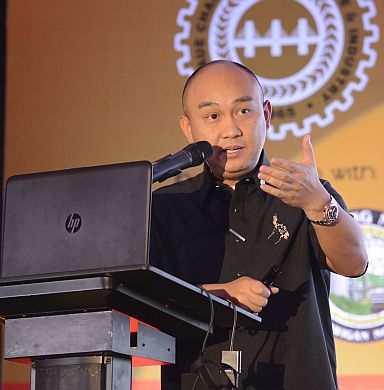
Dr. Ronald Mendoza, dean of Ateneo School of Government, discusses how big companies can help small businesses grow at a business summit organized by the Mandaue Chamber of Commerce and Industry in Mandaue City. (CDN PHOTO/CHRISTIAN MANINGO)
“Keep on expanding. That is what the country needs to do.”
Dr. Ronald Mendoza, dean of the Ateneo School of Government, issued this challenge to large businesses especially in the manufacturing sector, which could become links between small enterprises and true progress.
Mendoza said the country’s macroeconomics is in excellent shape but challenges remain for micro, small, and medium-sized enterprises (MSMEs).
Much of the population, labor, and MSMEs are not connected to the dynamic growth we are experiencing,” Mendoza said during the Mandaue Chamber of Commerce and Industry (MCCI) Business Summit on Wednesday.
Speaking to close to 400 Mandaue City-based business people, Mendoza said many of today’s biggest firms in the country had not really done things that connect poor regions to that dynamic growth.
He encouraged the members of the MCCI and other businessmen at the summit to take advantage of present opportunities and expand.
Manufacturing
He cited the manufacturing sector as among those that could link with MSMEs and poor communities, since it would need a large workforce, lifting families out of poverty through the creation of jobs.
These businesses by expanding could act as links to MSMEs, who could be like suppliers to these firms, and in turn these small firms could also create jobs.
The government should also do their part.
Relaxed restrictions on foreign-direct investments would be needed to boost the manufacturing sector, said Mendoza.
Mendoza said there are 10 million unemployed and underemployed Filipinos at present with one million added to the unemployment pool each year.
Three different presidents whose collective terms will run until 2032 would need to generate 1.2 million jobs each year to end unemployment and underemployment.
But the country only produces more than 600,000 jobs on average annually, he said.
Challenge
The challenge now falls on entrepreneurs and managers, Mendoza said, to build competitive firms to beat competition from other countries and ensure that there are jobs for Filipinos here.
The Philippines’ economic growth has drastically accelerated over the decades with improvements seen from president to president.
The country’s economy grew by 5.8 percent in 2015 while it posted a 6.9 percent growth in Gross Domestic Product (GDP) in January this year, prompting economists and business leaders to project this upward trend to continue by the end of 2016.
Mendoza cited as among the achievements of the Aquino administration was the upgrading of the country’s credit rating to investment grade.
Where to invest
This brought down the debt to GDP ratio in the Philippines, a gauge measuring the government’s capacity to pay, which Mendoza said should encourage businesses to borrow and invest.
“It’s a happy situation, but the challenge is where to invest if we are to borrow,” he added.
Mendoza said the country’s biggest conglomerates were able to take advantage of cheap debt, getting bigger gains through capitalization and expansion.
But he said this did not translate to the alleviation of poverty in the country, which what inclusive growth espouses.
Latest statistics showed that 26 percent of Filipinos still live in poverty.
Mendoza said a vast majority of large enterprises, which account for only less than one percent of the whole business sector in the Philippines, is still very conservative.